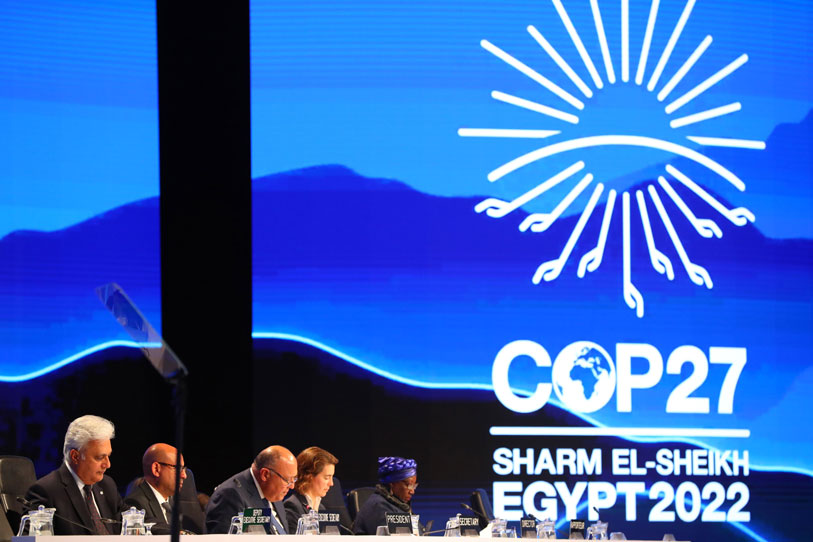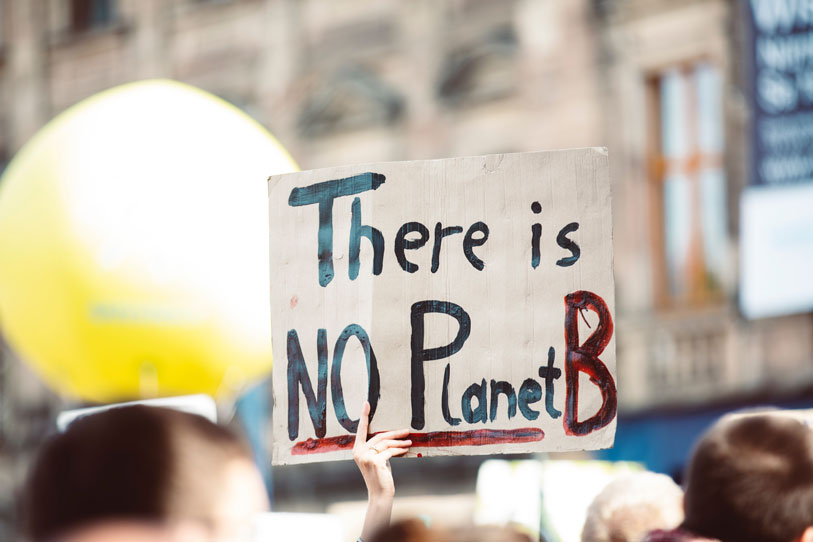29 November 2022
COP27, what outcome?
While the world is still divided over fossil resources, the “Loss and Damage” Fund for the most vulnerable countries gives a glimmer of hope. Generali’s commitment as a responsible insurer and investor.
Invest heavily in renewable energies, stop dependence on fossil fuels, and reach a climate solidarity pact in which all countries commit to reducing emissions during this decade, in line with the goal of keeping the global temperature rise at around 1.5°C. These are among the actions called for by Secretary General of the United Nations, Antonio Guterres, in his final message at the 27th United Nations Conference on Climate Change (COP27). Held from the 6th to the 18th of November in Sharm el-Sheikh, it was the first to be organised by an African country.

As Guterres pointed out, this year’s COP took place “not far from Mount Sinai, a site that is central to many faiths and to the story of Moses, or Musa”, and said it was a “fitting” place to hold the conference. He continued by saying that climate chaos is a crisis of biblical proportions: “The signs are everywhere. Instead of a burning bush, we face a burning planet.”
The previous COP26 in Glasgow established a series of highly ambitious commitments including, for instance, the allocation of 100 billion US dollars per year to developing countries. However, the actions planned to achieve the targets established during the 2015 COP21 in Paris are currently falling short of expectation. According to the AR6 – Sixth Assessment Report published by the Intergovernmental Panel on Climate Change (IPCC) and focusing on climate change mitigation and adaptation, without “immediate and deep” emission reductions across all sectors it is impossible to limit global warming to 1.5°C above pre-industrial levels.
An uncertain outcome
Although the COP27 did not lead to any real progress with regard to commitments to phase out fossil fuels, there was nevertheless a silver lining with the creation of the first Loss and Damage Fund, which aims to help especially the most vulnerable countries to cover the costs of the impact of climate change. Regarding mitigation, the parties agreed that limiting global warming to 1.5°C requires rapid, deep, and sustained reductions in global greenhouse gas emissions, which must be reduced by 43% from 2019 levels by 2030. The parties also reiterated the Glasgow Climate Pact’s call for updating nationally determined contributions (NDCs) as needed, in order to meet the Paris Agreement targets by the end of 2023.
Meanwhile, the war in Ukraine has highlighted the global economy’s heavy dependence on fossil fuels and the increasing need to push for an energy transition. As shown in a recent analysis by Climate Action Tracker (CAT), various countries are increasingly racing to grab gas supplies as a result of that conflict, which undermines the goals of the Paris Agreement. In particular, by 2030 expanding Liquefied Natural Gas (LNG) capacity could increase emissions by more than 1.9 billion tonnes of carbon dioxide per year above emission levels consistent with the International Energy Agency’s (IEA) 2050 “Net-Zero”1 target.
It is worth mentioning the substantial differences in terms of climate consequences between the various levels of temperature increase. According to recent research by the National Oceanic and Atmospheric Administration (NOAA), it is likely that the world’s temperature will increase by more than 3°C, which is an alarming scenario, unless the global economy is radically transformed. According to estimates:
- just 1.5°C of warming will cause sea levels to rise by 48 centimetres by the end of the century. Moreover, according to estimates, there would be on average up to 19 more days of extreme heat per year, with heatwaves lasting about 17 days longer than the average currently recorded.
- A 2°C rise in temperature would raise the sea level by 56 centimetres and bring about 29 more days of extreme heat, with heatwaves lasting up to 35 days longer.
- With a 3°C increase in temperature, it is unclear how much sea levels would rise due to so-called ‘feedback loops’, which lead to a kind of chain reaction that can exacerbate the impact of climate change, causing the melting of global ice to accelerate exponentially. Eight of the world’s ten largest cities are coastal, and would face significant flooding, erosion, and storm surges, even in the mildest scenario. Hundreds of millions of people would be displaced from their homes due to rising sea levels.

Generali’s commitment as a responsible insurer and investor
In order to align its portfolio with the long-term Paris commitments, in 2020 Generali joined the Net-Zero Asset Owner Alliance (a UN-convened group of international investors committed to decarbonizing their portfolios to net-zero emissions by 2050) and in 2021 joined the Net-Zero Insurance Alliance as a founding member, aiming to involve global insurance leaders in the key goal of reaching zero net greenhouse gas emissions attributable to insurance portfolios by 2050. In this context, the Group’s Strategy on Climate Change is the key reference point: it provides an overview of the decisions taken to promote a fair and socially just transition to a net-zero emission economy.
Concerning sustainable insurance solutions, Generali is committed to developing and sharing best practices for risk-taking in the renewable energy sector. Its goal is to increase product offering with environmental and social value with GWP CAGR +5%-7% in the period 2022-2024. On the investment front, Generali plans to make between 8.5 billion euros and 9.5 billion euros of additional green and sustainable investments by 2025, compared to those already made at the end of 2020.
In 2021, Generali recorded 19.9 billion euros in premiums from social and environmental products and allocated more than 2.5 billion euros to new green and sustainable investments, reducing the carbon intensity of investments by 29.6 percent.
Generali does not insure the oil and gas sector with respect to exploration and production activities, nor their expansion. Specific rules have been established to avoid supporting the thermal coal and unconventional fossil fuels industry, including operations in the Arctic. Furthermore, Generali is committed to phasing out investments in and underwriting exposure to the coal sector by 2030 for OECD countries and by 2040 for the rest of the world.
In recent years, Generali has become a spokesperson for the “just transition” principles through engagement activities. This activity has traditionally been aimed at energy companies in countries that are heavily dependent on coal as a primary energy resource, in order to speed up their energy transition, and combines energy transition strategies with measures to protect communities and workers. This is based on the principle that the key to success lies in changing together, as an integrated economic system, rather than simply disinvesting, which is considered the last, most extreme resort.
Moreover, the Group has taken action to decarbonize its operations: by the end of 2025, in line with climate science, Generali intends to reduce greenhouse gas emissions from offices, data centers and employee mobility by at least 25% compared to base year 2019. The Group also aims to purchase energy from 100% renewable sources whenever possible and is committed to further improving energy efficiency.
Generali also supports the Task Force on Climate-Related Financial Disclosure (TCFD), and voluntarily commits to reporting governance issues as well as the risks and opportunities related to climate change in a transparent way.
The results achieved have enabled the Group to position itself among the global sustainability leaders in the insurance industry. Sustainability is the originator of the Lifetime Partner 24: Driving Growth strategic plan, which guides the Group’s actions by building on the foundations of the previous strategic cycles. By 2024, the goal is to continue achieving a positive and relevant social and environmental impact on all stakeholders by increasingly integrating sustainability into processes and business decisions. Being aware, at the same time, that there is yet much more to be done to protect the future of generations to come.
1 Net zero emissions are achieved when anthropogenic emissions of greenhouse gases to the atmosphere are balanced by anthropogenic removals over a specified period. Where multiple greenhouse gases are involved, the quantification of net zero emissions depends on the climate metric chosen to compare emissions of different gases (such as global warming potential, global temperature change potential, as well as the chosen time horizon). Source: https://www.ipcc.ch/sr15/chapter/glossary/
